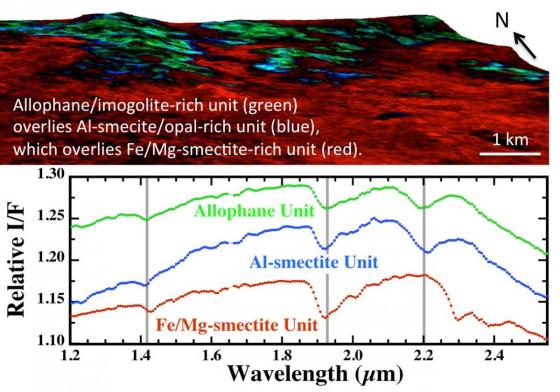From wet and warm to dry and cold - Mars' environmental evolution is revealed.

The early martian climate remains hotly debated by scientists because the surface mineralogy and morphology indicate abundant liquid water was present while atmospheric modeling is challenged to create conditions supportive of liquid water on the surface of early Mars. New results by SETI Institute researcher Dr. Janice Bishop and Houston colleague Dr. Elizabeth Rampe indicate a change in climate from the environment supporting liquid water and formation of clay minerals to an environment where liquid water was no longer abundant on the surface. This study is published in the August issue of EPSL.

http://www.sciencedirect.com/science/article/pii/S0012821X16302035
Study lead author Dr. Bishop chose a site on Mars called Mawrth Vallis for the investigation “due to the great diversity of clays and other minerals formed by interactions with water in this location.” In addition to the crystalline phyllosilicates discovered previously, this study identified poorly crystalline Al- and Si-rich materials. This study demonstrates that the poorly crystalline aluminosilicates allophane and imogolite comprise a significant portion of the uppermost stratum of the clay-rich units. “These phases are unique to immature soils derived from volcanic ash in well-drained, mildly acidic environments on Earth,” according to Dr. Rampe. This study documents a transition through time from the lowermost, smectite-bearing units to the uppermost allophane/imogolite unit at Mawrth Vallis. Bishop emphasizes “the importance of these results lies in that they signify a change in climate on Mars from a warm and wet environment to one where water was sporadic and likely depleted rapidly”.
Two kinds of spectral images were used from martian orbiters: data from the visible/near-infrared CRISM [JB1] (Compact Reconnaissance Imaging Spectrometer for Mars) instrument on the Mars Reconnaissance Orbiter and data from the thermal-infrared TES [JB2] (Thermal Emission Spectrometer) instrument on the Mars Global Surveyor orbiter. “The results from these two spectrometers had been conflicting in the past with regard to clay mineral detections, so the agreement reached in this study marks a monumental step forward in our understanding of these important indicators of water on the red planet” says Dr. Bishop. Modeling of the TES data in this new study indicates that about half of the surface rocks in light-toned regions are comprised of clays, silica and poorly crystalline aluminosilicates, which is in agreement with modeling of the CRISM data.
View of CRISM image showing allophane/imogolite unit above the crystalline clays.

TES model results showing the presence of ~50% poorly crystalline aluminosilicates, phyllosilicates and opal/glass phases, which is comparable to VNIR modeling results indicating ~50% clays.
Revised - SETI Institute Science Blog text – 29 Aug 2016
EPSL paper published online, to be published in print in August, 2016





